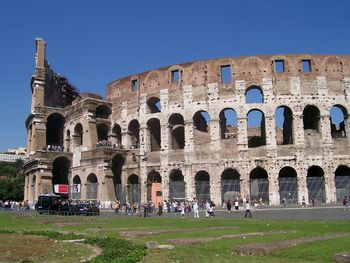Colosseum: Difference between revisions
Jump to navigation
Jump to search

imported>Richard Nevell (Added an image) |
mNo edit summary |
||
| (4 intermediate revisions by 3 users not shown) | |||
| Line 1: | Line 1: | ||
{{subpages}} | {{subpages}} | ||
{{Image|Colosseum.jpg|right|350px|The iconic [[Colosseum]] was founded by the Emperor [[Vespasian]] in the 1st century A.D.}} | {{Image|Colosseum.jpg|right|350px|The iconic [[Colosseum]] was founded by the Emperor [[Vespasian]] in the 1st century A.D.}} | ||
The '''Colosseum''' in Rome is a grand amphitheatre built during the reign of the Emperor [[Vespasian]] in the 1st century A.D. Vespasian became emperor in A.D. 69 after a period of civil war and construction began in A.D. 72. The structure has only been known as the Colosseum since the Middle Ages, and in the Roman period was simply called The Amphitheatre.<ref>Hopkins, Keith & Beard, Mary (2005). ''The Colosseum''. Harvard University Press. pp. 26–28. ISBN 9780674018952.</ref> Since 1980, the Colosseum has been part the UNESCO's World Heritage site 'Historic Centre of Rome, the Properties of the Holy See in that City Enjoying Extraterritorial Rights and San Paolo Fuori le Mura'.<ref>[http://whc.unesco.org/en/list/91 Historic Centre of Rome, the Properties of the Holy See in that City Enjoying Extraterritorial Rights and San Paolo Fuori le Mura], UNESCO. Accessed 17 October 2012.</ref> | |||
==References== | |||
{{reflist}}[[Category:Suggestion Bot Tag]] | |||
{{reflist}} | |||
Latest revision as of 16:00, 30 July 2024
The Colosseum in Rome is a grand amphitheatre built during the reign of the Emperor Vespasian in the 1st century A.D. Vespasian became emperor in A.D. 69 after a period of civil war and construction began in A.D. 72. The structure has only been known as the Colosseum since the Middle Ages, and in the Roman period was simply called The Amphitheatre.[1] Since 1980, the Colosseum has been part the UNESCO's World Heritage site 'Historic Centre of Rome, the Properties of the Holy See in that City Enjoying Extraterritorial Rights and San Paolo Fuori le Mura'.[2]
References
- ↑ Hopkins, Keith & Beard, Mary (2005). The Colosseum. Harvard University Press. pp. 26–28. ISBN 9780674018952.
- ↑ Historic Centre of Rome, the Properties of the Holy See in that City Enjoying Extraterritorial Rights and San Paolo Fuori le Mura, UNESCO. Accessed 17 October 2012.
